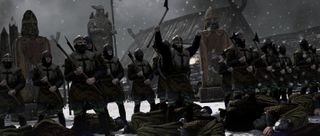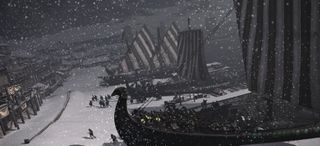Total War: Attila devs talk units, Hun politics and the apocalypse

PC Gamer: Those pressures seem to be reflected in the objectives now, they way they're tiered and they can push you around. It's not so much “just capture two territories over here.”
Simon Mann: We've tried to guide a little bit. We've got the seven seals of the apocalypse, as each of these seals breaks you get one step closer to Armageddon and the world ending completely, which is what the Romans thought was happening. Attila the Hun was death on a horse, and you didn't really want to get involved.
Essentially from that perspective we are pushing the player to do these things, and we're giving them suggestions. We have optional missions. For the vandals, one of your optional missions is go and take north Africa, because that's what they did in history, but at the same time we're a sandbox, so if you want to ignore that stuff and play it your way, we're not going to penalize you for doing that.
Pawel Wojs: Going back to the religion, that's a really nice point because we are telling that story of the apocalypse as seen through the eyes of the Catholic factions. So we are focusing on west and east Rome, and how they literally thought the world was going to end because of the climate change and how Attila was this god coming to punish them for their sins. It's a really nice, and quite powerful narrative wrapper to the game.
PC Gamer: There seem to be a whole bunch of subtle combat changes in addition.
Pawel Wojs: We've tried to de-clutter the UI as much as possible. We realize that there's a lot of information to take in. We've got a really complex battle simulation, probably one of the most complex there is, and it's real time. So there's an awful lot for a player to take on, so we've tried to bring important information from consent that will also make it easily digestible for players who maybe don't want to be number heavy.
So, for example, when you've got a unit selected you can see their threat, so you can see every enemy unit will show you from green to red, how much of a threat it is against your unit, so you know what your unit will be effective against. We've added tiers so, as well as the standard balancing, like in general cavalry will beat archers, for example, however we now have tiers, you have tiers one, two and three. A tier three archer will beat a tier one cavalry because the tier is literally an era up in technology.
PC Gamer Newsletter
Sign up to get the best content of the week, and great gaming deals, as picked by the editors.
The Romans have some of the strongest tier three units in whole game, but their tier one units are badly equipped barbarians. And they're not very good, which is why the Romans get their ass handed to them at the very start of the game. But once they've tech'd up to tier three, they will be romping across Europe quite happily again.

PC Gamer: That's very Roman isn't it? They were slow to mobilise, but unstoppable once they got there.
Pawel Wojs: We've very much changed the feeling of the battles as well. Balancing fatigue...
Simon Mann: Morale.
Pawel Wojs: Morale. So units will break, but also they can come back more so than before, before they completely run away. The feel and pacing of the battles is also very different.
Simon Mann: We've worked on siege battles as well. From our metrics we understand that siege battles are probably the most played battle type in Rome II, so we've put a lot of effort into building that. We've taken a nice reductive view of our map design, we're trying to simplify things. The visual language of the maps, and the flow of the maps can be really important, and this ties into things like escalation. Minor settlements now have towers defending them and small wall pieces that you can garrison archers and stuff on as a kind of defensive measure.
Pawel Wojs: You can upgrade those minor settlements as well, to actually put a wall around them, so you can fortify what, in Rome, were unfortified settlements.
Simon Mann: Yeah, and I think that escalation is the core of that. As you siege a settlement over turns on the campaign map it'll be taking more and more damage. And this is all dynamic. The amount of war damage you've got is based on the number of times you have sieges because your units are dealing a certain amount of damage to the settlement every time.
Pawel Wojs: And that's key as well. A fortified settlement with a big wall around it actually means something. You can't just roll up and attack. You can't do that, you'll bounce off the walls, you'll lose. You can't even engage in a battle unless you have some kind of artillery with you, or until you've maintained a siege and built siege weapons.
Simon Mann: Or, if through escalation you've breached the walls as well.
Pawel Wojs: Yes.
Simon Mann: You don't need to build siege craft if you just siege it long enough.
Part of the UK team, Tom was with PC Gamer at the very beginning of the website's launch—first as a news writer, and then as online editor until his departure in 2020. His specialties are strategy games, action RPGs, hack ‘n slash games, digital card games… basically anything that he can fit on a hard drive. His final boss form is Deckard Cain.
Most Popular


